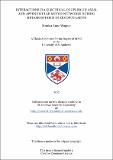Files in this item
Interactions via electrical coupling in axial and appendicular motor networks during metamorphosis in Xenopus laevis tadpoles
Item metadata
| dc.contributor.advisor | Sillar, Keith T. (Keith Thomas) | |
| dc.contributor.author | Wagner, Monica Anne | |
| dc.coverage.spatial | 104 p. | en_US |
| dc.date.accessioned | 2017-11-06T16:00:38Z | |
| dc.date.available | 2017-11-06T16:00:38Z | |
| dc.date.issued | 2017-06-20 | |
| dc.identifier.uri | https://hdl.handle.net/10023/12010 | |
| dc.description.abstract | The spinal locomotor networks in Xenopus laevis frog tadpoles undergo a remarkable transformation during metamorphosis to accommodate a switch from axial-based swimming to a limb-based kicking locomotor strategy. For a brief period during ontogeny, both the axial- and limb-based systems are present and functional, but reliant on different central pattern generators (CPGs) that are simultaneously active. However, the mechanisms controlling the functional coupling both within and between these locomotor networks are unknown. At metamorphosing larval stages (52-58), retrograde motoneuron (MN) backfilling from both axial (11th-12th post-otic segments) and hindlimb muscles with fluorescent rhodamine- and fluorescein-conjugated dextran dyes revealed two discrete MN populations (axial and appendicular) within the spinal cord. The co-labelling of both axial and appendicular cells provides evidence that the two MN pools in the lumbar enlargement are coupled. Electrophysiological data from animals at the same larval stages suggest that axial CPG excitability is modified as burst durations were increased by gap junction (GJ) blockers (18-β-glycyrrhetinic (18-β-GA) acid 100µM; CBNX 200µM), however, limb CPG burst parameters were not altered by GJ block. For spontaneous fictive locomotor bouts, the number of axial episodes initially increased, but then sharply decreased from control levels ~15-30 minutes after drug application. Coordinated and simultaneous axial and limb CPG output was observed with electrical stimulation to the optic tectum, an axial ventral root (VR), and a limb VR; GJ block did not affect the coordinated output from optic tectum stimulation, however, it decreased simultaneous output when the axial VR was stimulated. This novel finding that antidromic stimulation of an axial VR is sufficient to activate a different CPG for the limbs suggests there is synaptic coupling in the direction of axial to limb. These data suggest that axial CPG output is in part regulated by GJs. The anatomical data also suggest a connection exists between the axial and limb MN pools, and may be involved in the initial cycle-by-cycle coupling of the two CPG outputs. Thus the rhythm of the appendicular CPG is initially highly dependent on that of the axial CPG, which in turn is dependent on its own GJ connections within the spinal circuit. It appears that the immature limb MN pools in the lumbar spinal cord possess functional connections via electrical synapses to the axial locomotor system, which are presumably “pruned” as metamorphosis proceeds, and eventually lost completely by the adult stages when the limb network has become completely independent. | en_US |
| dc.language.iso | en | en_US |
| dc.publisher | University of St Andrews | |
| dc.rights | Attribution-NonCommercial-NoDerivatives 4.0 International | * |
| dc.rights.uri | http://creativecommons.org/licenses/by-nc-nd/4.0/ | * |
| dc.subject | Xenopus laevis tadpole | en_US |
| dc.subject | Locomotion | en_US |
| dc.subject | Development | en_US |
| dc.subject | Central pattern generator (CPG) | en_US |
| dc.subject | Gap junction / electrical coupling | en_US |
| dc.subject | Metamorphosis | en_US |
| dc.subject.lcc | QL668.E265W24 | |
| dc.subject.lcsh | Xenopus laevis--Development | en |
| dc.subject.lcsh | Tadpoles--Locomotion | en |
| dc.subject.lcsh | Amphibians--Metamorphosis | en |
| dc.title | Interactions via electrical coupling in axial and appendicular motor networks during metamorphosis in Xenopus laevis tadpoles | en_US |
| dc.type | Thesis | en_US |
| dc.type.qualificationlevel | Doctoral | en_US |
| dc.type.qualificationname | MPhil Master of Philosophy | en_US |
| dc.publisher.institution | The University of St Andrews | en_US |
The following licence files are associated with this item:
This item appears in the following Collection(s)
Except where otherwise noted within the work, this item's licence for re-use is described as Attribution-NonCommercial-NoDerivatives 4.0 International
Items in the St Andrews Research Repository are protected by copyright, with all rights reserved, unless otherwise indicated.


